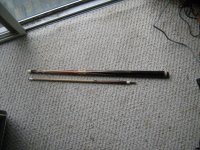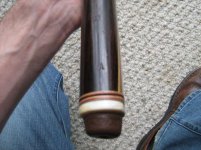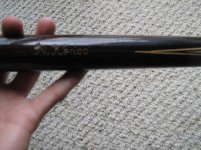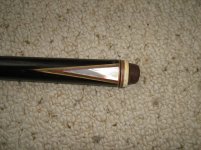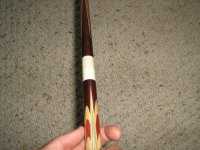I'm looking for more information on the cue pictured below. It looks old and has some markings on it, but what really threw me was the joint placement. The butt is much longer than the shaft. Any insight into this cue would be appreciated.
Thank you,
Mike
Mike the cue could be a Brunswick 360 cue, but there is no guaranty there were a number cue makers in the 1900-1940 time frame who build similar cues.
Rieper Manufacturing company was building these cues from around 1910-1930 when they closed their door's, and many believe that their cues were Superior to Brunswick's. One problem identifying the cue is that it doesn't have a label and Rieper for one did not mark their cues until the 1920's, so it takes an expert to identify the cue as Rieper.
Samuel Blatt, you may want to also do some research on the Samuel Blatt Company. They operated out of New York from 1923 until present day. They also made Trophy cues during the 1920's - 1930's, and Samuel also supplied parts to Brunswick during that such as Buckhorn Ferrules. Many cue makers of the time used Brunswick's cues to convert to make Trophy cues.
Oliver Briggs Company was another small cue company that was operating starting in 1910 in Boston, Massachusetts.
Albert Pick Company was also making cues from 1920's - 1930's in Chicago, Illinois. This company also made Trophy cues, and some of their designs are sought after by serious collectors because of the beauty and their rarity. Most of their cues were marked with a round or Sheild shaped decal similar to Brunswick's but not all of them.
Mike the reason the shaft of your cue shorter than the cues butt is because cues like the one you have pictured were made as one piece cues and then cut so that a joint could be added. Most examples of the cue you have pictured that I have seen were either one piece or had a shorter shaft if they were two piece. The reason the shaft length will vary is because the cue maker want to balance the cue when the extra weight was added at the joint during conversion to a two piece cue.
Mike the cue is very rare, and it is valued between $2500 and $6000 depending upon the condition which appears to be very good for the cue pictured, collector interest at the time, and the woods and other materials used.
Mike I do not believe the cue is a Brunswick, I suspect that it could have been made by Albert Pick, what I am solely basing this upon is the cues bumper, Brunswick used a flat piece of Black Fiber or other material which was glued to the Ivory. That is the design and style of Bumper that Albert Pick used on cues that they made, I have never seen a Brunswick model 360 with that style bumper, but this is just my opinion.
Here is a photo of an Albert Pick cue in my collection that is all original, the bumper used on your cue is very similar, and to my knowledge Albert Pick was the only one using this style bumper.

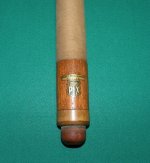
Hope this helps!!
